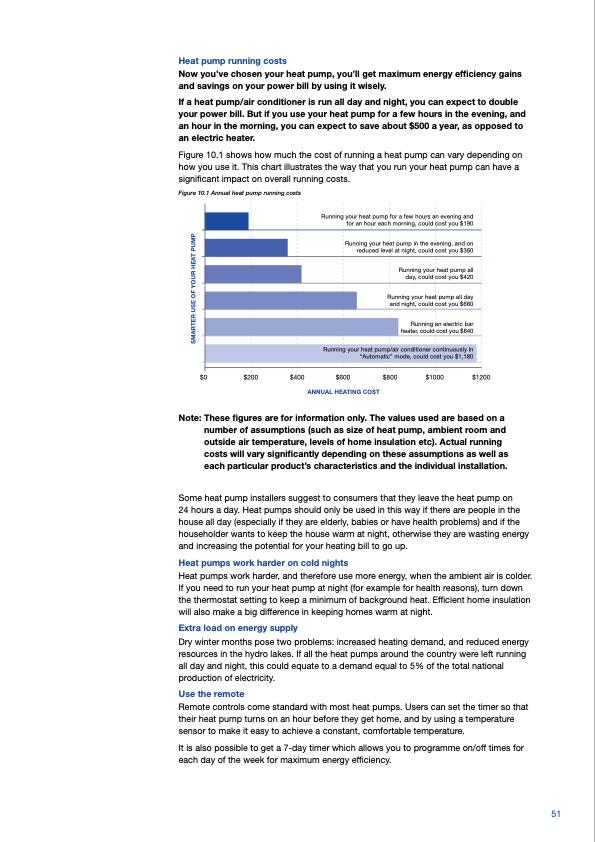
PDF Publication Title:
Text from PDF Page: 051
Heat pump running costs Now you’ve chosen your heat pump, you’ll get maximum energy efficiency gains and savings on your power bill by using it wisely. If a heat pump/air conditioner is run all day and night, you can expect to double your power bill. But if you use your heat pump for a few hours in the evening, and an hour in the morning, you can expect to save about $500 a year, as opposed to an electric heater. Figure 10.1 shows how much the cost of running a heat pump can vary depending on how you use it. This chart illustrates the way that you run your heat pump can have a significant impact on overall running costs. Figure 10.1 Annual heat pump running costs Running your heat pump for a few hours an evening and for an hour each morning, could cost you $190 Running your heat pump in the evening, and on reduced level at night, could cost you $360 Running your heat pump all day, could cost you $420 Running your heat pump all day and night, could cost you $660 Running an electric bar heater, could cost you $840 Running your heat pump/air conditioner continuously in “Automatic” mode, could cost you $1,180 $0 $200 $400 $600 $800 $1000 $1200 ANNUAL HEATING COST Note: These figures are for information only. The values used are based on a number of assumptions (such as size of heat pump, ambient room and outside air temperature, levels of home insulation etc). Actual running costs will vary significantly depending on these assumptions as well as each particular product’s characteristics and the individual installation. Some heat pump installers suggest to consumers that they leave the heat pump on 24 hours a day. Heat pumps should only be used in this way if there are people in the house all day (especially if they are elderly, babies or have health problems) and if the householder wants to keep the house warm at night, otherwise they are wasting energy and increasing the potential for your heating bill to go up. Heat pumps work harder on cold nights Heat pumps work harder, and therefore use more energy, when the ambient air is colder. If you need to run your heat pump at night (for example for health reasons), turn down the thermostat setting to keep a minimum of background heat. Efficient home insulation will also make a big difference in keeping homes warm at night. Extra load on energy supply Dry winter months pose two problems: increased heating demand, and reduced energy resources in the hydro lakes. If all the heat pumps around the country were left running all day and night, this could equate to a demand equal to 5% of the total national production of electricity. Use the remote Remote controls come standard with most heat pumps. Users can set the timer so that their heat pump turns on an hour before they get home, and by using a temperature sensor to make it easy to achieve a constant, comfortable temperature. It is also possible to get a 7-day timer which allows you to programme on/off times for each day of the week for maximum energy efficiency. 51 SMARTER USE OF YOUR HEAT PUMPPDF Image | Heat pump installation Good Practice Guide

PDF Search Title:
Heat pump installation Good Practice GuideOriginal File Name Searched:
Good_practice_heat_pump_installation.pdfDIY PDF Search: Google It | Yahoo | Bing
CO2 Organic Rankine Cycle Experimenter Platform The supercritical CO2 phase change system is both a heat pump and organic rankine cycle which can be used for those purposes and as a supercritical extractor for advanced subcritical and supercritical extraction technology. Uses include producing nanoparticles, precious metal CO2 extraction, lithium battery recycling, and other applications... More Info
Heat Pumps CO2 ORC Heat Pump System Platform More Info
| CONTACT TEL: 608-238-6001 Email: greg@infinityturbine.com | RSS | AMP |